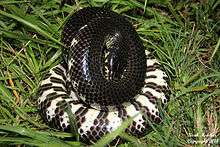Mud snake
| Mud snake | |
|---|---|
 | |
| Western mud snake, Farancia abacura reinwardtii, in Illinois | |
| Scientific classification | |
| Kingdom: | Animalia |
| Phylum: | Chordata |
| Subphylum: | Vertebrata |
| Class: | Reptilia |
| Order: | Squamata |
| Suborder: | Serpentes |
| Family: | Colubridae |
| Subfamily: | Xenodontinae |
| Genus: | Farancia |
| Species: | F. abacura |
| Binomial name | |
| Farancia abacura (Holbrook, 1836) | |
| Synonyms | |
| |
The mud snake (Farancia abacura) is a species of nonvenomous, semiaquatic, colubrid snake endemic to the southeastern United States.[2]



Description
Mud snakes usually grow to a total length (including tail) of 40 to 54 inches (1-1.4 m),[3] with the record total length being slightly over 80 inches (2 m).[4]
The upperside of the mud snake is glossy, black. The underside is red and black, and the red extends up the sides to form bars of reddish-pink.
Their heavy bodies are cylindrical in cross section, and their short tails have a terminal spine.
Their head scalation is distinctive in that they have only one internasal, no preocular, and one anterior temporal. The dorsal scales are smooth, and are arranged in 19 rows at midbody. Ventrals 168-208; anal plate divided; subcaudals 31-55.[5]
Habitat
Mud snakes inhabit the edges of streams and cypress swamps, among dense vegetation or under ground debris. Mud snakes are commonly used as reference points for several other characters.
Behavior
Mud snakes are mostly aquatic, and nocturnal as they prey on amphibians. They are known to use their sharply pointed tails to prod prey items, leading to the nickname "stinging snake".
Reproduction
Breeding takes place in the spring, mostly in the months of April and May. Eight weeks after mating, the female lays 4 to 104 eggs in a nest dug out of moist soil. She will remain with her eggs until they hatch,[6] in the fall, usually September or October. They can also be born in winter, which is the most common time.
Geographic range
The mud snake is found in the southeastern United States, in the states of Alabama, Arkansas, Florida, Georgia, Utah, Illinois, Kentucky, Louisiana, Mississippi, Missouri, North Carolina, Oklahoma, South Carolina, Tennessee, Texas, and Virginia.[2]
Cultural significance
The mud snake is one of a few animals which may be the origin of the hoop snake myth. J.D. Willson writes:
| “ | Mud snakes are sometimes known as “hoop snakes” because of the myth that they will bite their own tail and roll after people.[2] | ” |
The hoop snake myth has also been attributed to the coachwhip snake.
Subspecies
There are two recognized subspecies of Farancia abacura, including the nominotypical subspecies:
- Farancia abacura abacura (Holbrook, 1836) - eastern mud snake
- Farancia abacura reinwardtii (Schlegel, 1837) - western mud snake
References
- ↑ Boulenger, G.A. 1894. Catalogue of the Snakes in the British Museum (Natural History). Volume II., Containing the Conclusion of the Colubridæ Aglyphæ. Trustees of the British Museum (Natural History). (Taylor and Francis, Printers.) London. xi + 382 pp. + Plates I.-XX. (Farancia abacura, pp. 291-292.)
- 1 2 3 Willson, J.D. 2006. Mud Snake (Farancia abacura) Savannah River Ecology Laboratory. Accessed April 23, 2011.
- ↑ Missouri Department of Conservation. 2013. Western Mud Snake MDC Online. Accessed May 18, 2013
- ↑ The University of Georgia. 2008. Mud Snake The University of Georgia: Museum of Natural History. Accessed April 23, 2011.
- ↑ Smith, H.M., and E.D. Brodie, Jr. 1982. Reptiles of North America: A Guide to Field Identification. Golden Press. New York. 240 pp. ISBN 0-307-13666-3. (Farancia abacura, pp. 162-163.)
- ↑ Goin, C.J.; O.B. Goin; G.R. Zug. 1978. Introduction to Herpetology, Third Edition. W.H. Freeman. San Francisco. xi + 378 pp. ISBN 0-7167-0020-4. ("Parental Care", Farancia abacura, p. 121.)
External links
- Species Farancia abacura at The Reptile Database
- Illinois Natural History Survey: Farancia abacura
- "Black Snakes": Identification and Ecology - University of Florida fact sheet
Further reading
- Conant, R. 1975. A Field Guide to Reptiles and Amphibians of Eastern and Central North America, Second Edition. Houghton Mifflin. Boston. xviii + 429 pp. ISBN 0-395-19979-4 (hardcover), ISBN 0-395-19977-8 (paperback). (Farancia abacura, pp. 176–177 + Plate 25 + Map 138.)
- Conant, R., and W. Bridges. 1939. What Snake Is That? A Field Guide to the Snakes of the United States East of the Rocky Mountains. (With 108 drawings by E. Malnate.) D. Appleton-Century. New York and London. Frontispiece map + viii + 163 pp. + Plates A-C, 1-32. (Farancia abacura, pp. 33–36 + Plate 3, Figure 7.)
- Goldstein, R.C. 1941. Notes on the Mud Snake in Florida. Copeia 1941 (1): 49-50.
- Holbrook, J.E. 1836. North American Herpetology; or, A Description of the Reptiles Inhabiting the United States. Vol. I. J.Dobson. Philadelphia. 120 pp. (Coluber abacurus, pp. 119–120.)
- Meade, G.P. 1937. Breeding Habits of Farancia abacura in Captivity. Copeia 1937 (1): 12-15.
- Morris, P.A. 1948. Boy's Book of Snakes: How to Recognize and Understand Them. A volume of the Humanizing Science Series, edited by Jacques Cattell. Ronald Press. New York. viii + 185 pp. ("The Mud Snake", Farancia abacura, pp. 87–88, 179.)
- Schlegel, H. 1837. Essai sur la physionomie des serpens. M.H. Schonekat. Amsterdam. Partie Générale. xxviii + 251 pp. (Homalopsis reinwardtii, p. 173.) AND Partie Descriptive. 606 + xvi pp. (Homalopsis reinwardtii, pp. 357–358.)
- Schmidt, K.P., and D.D. Davis. 1941. Field Book of Snakes of the United States and Canada. G.P. Putnam's Sons. New York. 365 pp. (Farancia abacura, pp. 106–108, Figure 22. + Plate 9.)
- Wright, A.H., and A.A. Wright. 1957. Handbook of Snakes of the United States and Canada. Comstock. Ithaca and London. 1,105 pp. (in 2 volumes) (Farancia abacura, pp. 271–280, Figures 84-85., Map 25.)
